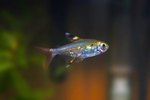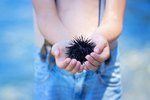
The Prionotus carolinus goes by the names sea robin, northern sea robin or common sea robin. It’s not a bird but is actually a member of the Triglidae family of fish, many of which often are called gurnards because of the grunting sound they make. While some sea robins have been reported to reach as much as 3 feet in length, most of them range from about 12 to 18 inches long.
Description
The sea robin is an elongated fish with a rounded front end and a long, tapering tail section. A series of bony plates covers their head, offering them some protection from predators. The upper portion of the sea robin can range from medium gray to reddish-brown, while its underside is quite pale by comparison. The dorsal fin is triangular and generally darker than the body; the fins on the fish’s underside are much lighter. It has oversized pectoral fins that somewhat resemble wings, giving rise to the nickname sea robin, and it has bright blue eyes.
Habitat
These fish live in tropical seas throughout the world and are particularly common in the Atlantic Ocean from Nova Scotia down to Florida. They typically inhabit shallow coastal waters but are sometimes found swimming freely in the open ocean or diving down to depths of more than 200 feet. Sea robins favor open areas of the ocean floor where the bottom is sandy or covered with small rocks. They breed during the summer months and mature adults typically remain in water that is 71 degrees or higher throughout July, August and September, to allow their eggs to hatch.
Behavior
Sea robins are good swimmers but they also can use their pectoral fins to “walk” along the bottom of the ocean, looking for prey. The sensitive fins let the fish feel things they encounter and they can be used to move and manipulate small objects. It also uses its head as a shovel to dig down and uncover small sea creatures to eat. Sea robins will eat just about anything they can find, including segmented worms, crustaceans, shrimp, squid and mollusks.
General Facts
Sea robins vibrate their swim bladders to make a croaking sound that is easy to hear when the fish are lifted out of the water. They head for the bottom and quickly burrow into the sand when threatened, leaving only their eyes and a bit of their heads exposed. When hooked, the sea robin is a strong fighter providing fisherman with a good battle. Even though the fish is edible, it’s often considered more of a nuisance than anything because of the many bony plates covering parts of it.
References
Photo Credits
-
Comstock/Comstock/Getty Images




